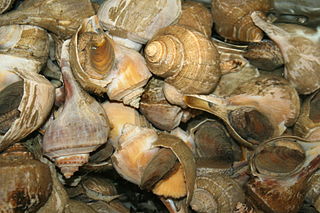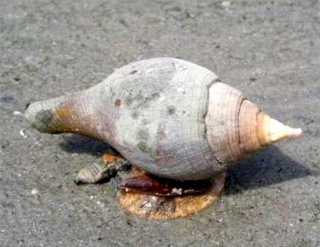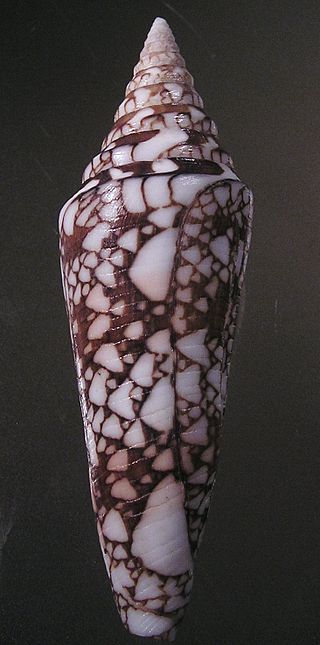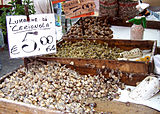
Murex is a genus of medium to large sized predatory tropical sea snails. These are carnivorous marine gastropod molluscs in the family Muricidae, commonly called "murexes" or "rock snails".

The knobbed whelk is a species of very large predatory sea snail, or in the US, a whelk, a marine gastropod mollusk in the family Busyconidae, the busycon whelks.

Busycotypus canaliculatus, commonly known as the channeled whelk, is a very large predatory sea snail, a marine prosobranch gastropod, a busycon whelk, belonging to the family Busyconidae.

The Buccinidae are a very large and diverse taxonomic family of large sea snails, often known as whelks or true whelks.

Thais, sometimes known by the common names dog winkles or rock shells, is a genus of medium to large predatory sea snails with an operculum, marine gastropod mollusks in the family Muricidae.

Sinistrofulgur perversum, the lightning whelk, is a species of very large predatory sea snail or whelk, a marine gastropod mollusc in the family Busyconidae, the busycon whelks. This species has a left-handed or sinistral shell. It eats mostly bivalves.

Sinistrofulgur contrarium is a fossil snail species of the busycon whelks in the family Busyconidae. There has been some confusion about the correct taxonomy of this species, which has been confused with the extant species Sinistrofulgur sinistrum Hollister, 1958, and Sinistrofulgur perversum

Busycotypus is a genus of very large sea snails, marine gastropod mollusks in the subfamily Busycotypinae.

Melongena is a genus of sea snails, marine gastropod mollusks in the family Melongenidae, the crown conches and their allies.

Pleuroploca is a genus of very large predatory sea snails with an operculum, marine gastropod mollusks in the family Fasciolariidae, which includes the spindle shells, the tulip shells and other allied genera.

Lithopoma is a genus of medium-sized to large sea snails with a calcareous operculum, marine gastropod mollusks in the subfamily Turbininae of the family Turbinidae, the turban snails.

Fulguropsis is a genus of sea snails, marine gastropod molluscs in the family Busyconidae, the crown conches and their allies.

Nassarius arcularia, the casket nassa or the little box dog whelk, is a species of sea snail, a marine gastropod mollusk in the family Nassariidae, the Nassa mud snails or dog whelks.

Bullia is a genus of sea snails, marine gastropod mollusks in the family Nassariidae, the Nassa mud snails or dog whelks.

Charonia lampas is a species of predatory sea snail, a marine gastropod mollusk in the family Charoniidae.

Turbinellinae are a subfamily of large deepwater sea snails, marine gastropod mollusks in the family Turbinellidae.

Leptoconus is a subgenus of sea snails, marine gastropod mollusks in the genus Conus, family Conidae, the cone snails and their allies.

The Busyconinae are taxonomic subfamily of large sea snails, often known as whelks. The name "whelk" also refers to Buccinidae. Busyconinae consists of Recent and fossil species.

Sinistrofulgur is a genus of large sea snails with left-handed shell-coiling, marine gastropod mollusks in the subfamily Busyconinae.

Sinistrofulgur sinistrum is an edible species of large predatory sea snail in the family Busyconidae, the busycon whelks. This species is often confused with Sinistrofulgur perversum, and with Busycon contrarium, which is now considered an exclusively fossil species.




















